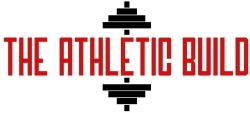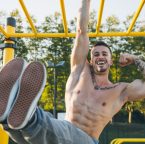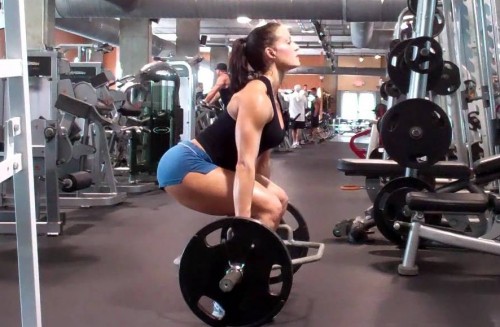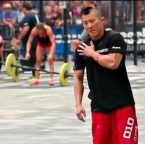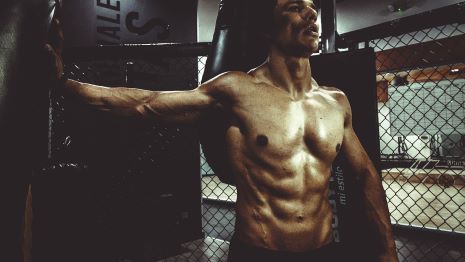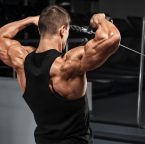Think you need a barbell and a gym membership to get jacked?
Yeah, that can help. But it’s not mandatory.
You can get strong, like, freakishly strong, just using your own body. No machines. No weights. Just you, gravity, and a little bit of floor.
In this article, we’re breaking down what calisthenics actually is, why it works, and how to use it to build real muscle and athletic power wherever you are.
Let’s go.
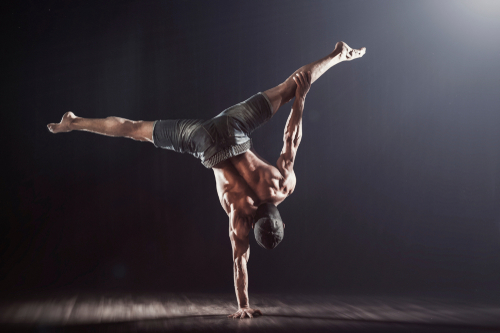
What Are Calisthenics
The term ‘calisthenics’ comes from the Greek words meaning beauty and exercise. Calisthenics is a form of exercise that does not use any weights.
Using calisthenics, you can get a fantastic workout for your whole body without needing to go to the gym.
Calisthenics is simply using your bodyweight as resistance and performing different movements or exercises to strengthen and tone through dynamic and static contraction.
Calisthenic exercises include pull-ups, push-ups, chin-ups, dips, squats, crunches, and more.
Benefits of Calisthenics
There are some major benefits to doing calisthenics training, some of these include:
It’s Basically Free
Calisthenics exercises such as pushups and pull-ups require nothing more than your body and maybe a pull-up bar although you could do pull-ups on a good tree branch or find a local playground and do your pull-ups there. That can get old pretty fast though so you are going to want to get yourself a pull-up bar of some kind before long, even if it’s homemade.
Calisthenics allow you to get a great workout without a gym membership.
You Can Do Calisthenics Anywhere
Calisthenics works your entire body and can be done anywhere. You don’t need any equipment, so you can do calisthenic exercises pretty much whenever and wherever you want to.
The only thing that matters is that there is enough space around you. You can do them in your living room, in a hotel room, at a park, or just about anywhere else. This gives you little to no excuse not to be doing them.
They Provide Functional Strength
You don’t always need to do body-part splits and specialized workouts involving multiple pieces of equipment to build muscle. Calisthenics can be just as effective. You can even gain strength for an athletic sport, like boxing, with calisthenics alone.
When you train with bodyweight exercises, your muscles must work against your own weight. Your core will engage to stabilize you throughout the movement. This functional training helps translate the benefits into everyday life or sport-specific tasks.
Anyone Can Do Calisthenics
No matter how old or heavy you are. Calisthenics can be done by everybody.
Movements can be modified to fit people of all fitness levels. No matter who you are, calisthenics are the perfect place for beginners to get started with their strength training.
Bodyweight Exercise Burns Fat and Builds Muscle
Calisthenics build lean and athletic muscle that looks good, not the stocky fireplug type of muscle you get with bodybuilding.
They also increase strength and flexibility while building endurance.
This lean muscle burns a lot more calories than fat at rest.
So, even without doing anything else but calisthenics every day for a year, most people will still get in much better shape due to the increased metabolism from the lean muscle they have gained.
Myths About Calisthenic Training
One of the main reasons people shy away from calisthenics is because they believe it’s only for the wimps. This is what calisthenics was all about back in the day before weights became popularized. So yes, at one point these exercises were performed by “wimps” but now they are used by everyone including the military. They are designed to give you an edge over your opponent, not make them feel bad about themselves.
The whole point of this section is to help you realize that calisthenics are anything but wimpy or for sissies. It’s actually pretty hardcore if you think about it because it can be used as a combat sport.
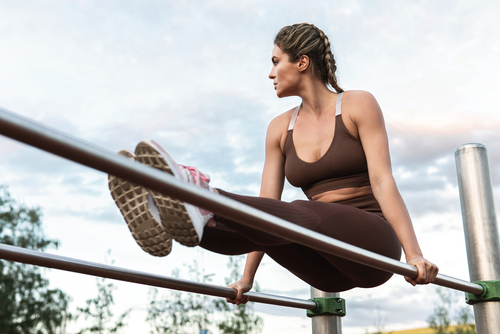
Calisthenics is a whole lot of fun and a great workout to do with your friends. Some may be intimidated by it, but it shouldn’t be like that. If you’re worried about getting picked on, then don’t go to the gym because people will treat you differently there, either.
Calisthenics are for everyone, no matter their level of fitness or gender. In saying that, it’s great for small children too.
Herschel Walker, one of the greatest running backs of all time, trained nothing but calisthenics, and he was a BEAST. So if you think they are for wimps, you should think again.
Related: 50 Crossfit Bodyweight Workouts
Related: Which is Better, Weight Training vs Calisthenics
Basic Calisthenics Exercises List
I’m going to list out some of the most beneficial calisthenics moves you can do and what muscles they work.
Pull-Ups
These are great for your back, biceps and forearms. Do these by hanging from a bar with an overhand grip, then pull your body up until your chin reaches the height of the bar. Do as many reps as you can or until failure. You can also use resistance bands to make this exercise easier if needed. These come highly recommended because they will develop both strength and size in your upper body.
A lot of “beginner calisthenics guides” out there seem to think that beginners should have no problem ripping off 10 pull-ups at a time. The truth is, a lot of people can’t do that especially beginners. If you are one of those people check out our guide to do more pull-up the easy way.
Related: The 11 Calisthenics Exercises for Building Muscle
Push-Ups
This is probably one of the best exercises around period, period meaning men AND women. This classic exercise will build your chest, shoulders and triceps. Do these by placing your hands on the ground just outside your shoulders, then lower until you touch the ground lightly with your chest. Push back up explosively till your arms are straight to complete one rep. If you need help, place your hands on an elevated surface like a chair or step to make it easier when starting out.
Once you get good at standard push-ups you can take it up a notch by doing them with your feet elevated or by moving your hands close together which makes them more difficult and puts more of an emphasis on the triceps.
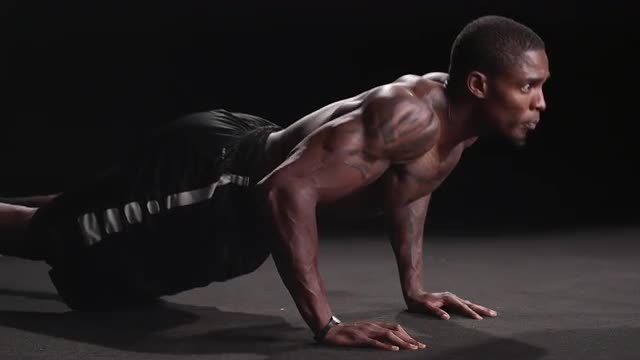
Squats
This is probably one of my favorite exercises that I actually enjoy doing because it builds real functional strength that carries over into everything I do. For this exercise, you want to make sure your feet are shoulder-width apart and your toes slightly pointed outwards. Lower by bending at the hips like you are sitting down, but make sure you stop when your thighs are parallel to the ground. Push up explosively until legs are straight to complete one rep. If needed, hold on to something sturdy for support.
I prefer jump squats where you jump at the top of the movement as they help you be more explosive. These are a bit more difficult but you should mix in some jump squats once you have mastered the bodyweight squats.
You can take this exercise to the next level by wearing a weighted vest or doing single-leg squats, also known as pistol squats.
Related: 21 Athletic Body Workouts You Can Do At Home
Dips

Dips are a killer exercise for the chest and triceps. You can do these at a dip station, or you can find a spot in your home that has a solid area for dips like between 2 countertops. To do these, lower by bending at the elbows until they are at a 90-degree angle which is known as full extension. Once here, push back up explosively till arms are straight to complete one rep. This exercise is highly recommended because it’s simple yet effective.
Lunges
You can do these by standing normally with feet together, then step forward with one leg. Once here, bend your front knee until your thigh is parallel to the ground. Ensure that you keep your back straight as you lower or else you will end up hurting yourself. Push up explosively till legs are straight to complete one rep. This exercise builds strength in the quads and glutes and also works on balance which is great for children and adults alike.
Mountain climbers
These are basically what they sound like. You’re going to be doing the exercise in a low push-up position then bringing your knees up towards your chest one leg at a time as if you were climbing a steep hill or a mountain. Sound easy enough? Try it! It’s actually more challenging than you think so if this is too hard for you, try putting both legs out at the same time instead of alternating between each leg. When doing these you keep an explosive pace; otherwise, your body won’t work as efficiently, making it less effective.
Crunches
To do these correctly, lie flat on your back with legs straight and arms either by your side or place them behind your head depending on what is more comfortable. Bring your legs off the ground and towards your chest at a 45-degree angle. Stop when your shoulder blades come off the floor as you squeeze your abs as hard as humanly possible. Once again, keep an explosive pace for this; otherwise, it won’t do much good.
Advanced Calisthenics Exercises
Once you have mastered the basic calisthenics exercises you can start to move on to some of these more advanced exercises.
Muscle Up
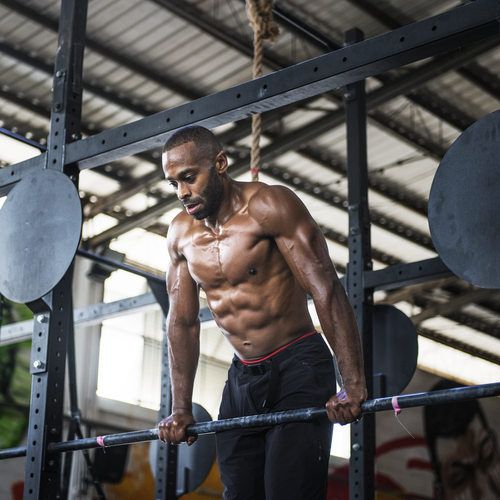
Muscle-ups are a common CrossFit exercise that is becoming more widespread, but that doesn’t mean it is easy.
To perform this exercise, pull yourself from a hanging position up to a top position where you have complete body control, so your head and the upper body goes over the bar, and your arms are fully locked at the top.
Planche
The Planche is an advanced gymnastic move that requires strength throughout your whole body and balance like nothing else. The planche involves holding yourself up horizontally (but not with your feet) and it takes time to build that kind of strength in all your joints and muscles.
Take these to the next level by doing single-handed planches or planche push-ups, or even planche push-ups.
One-Handed Pull-Ups
One-handed pull-ups are great for improving your grip strength as well as working out other parts of your upper body like lats, biceps, shoulders, forearms, etc.
Also, these are great for showing off. Your buddies and people at the gym will be pretty damn impressed when you start blasting out single arm pull-ups. How could they not be?
The Human Flag
The human flag is a calisthenic and gymnastic move that requires dynamic strength and stability. The human flag or bar hold is a feat of strength where the body is parallel to the ground supported by a vertical bar. A straight line is formed using the arms and body. The trick requires the performer to have extensive upper body strength, especially in the arms, shoulders, and core.
Take this one to the next level by doing human flag oblique crunches or human flag bicycles.
Handstand Push-Ups
The handstand push-up is precisely what it sounds like. You do push-ups from a handstand position. Don’t worry, you don’t have to balance in a handstand to do them. You can do them in a handstand while leaning up against a wall. It requires serious shoulder and tricep strength. It is also a killer exercise that is definitely not for beginners.
If you want to take these to the next level, try doing some clapping handstand push-ups. It may sound impossible, but it’s not.
Want to go even further still? Then try the one-arm handstand push-up; this exercise requires as much strength as it does technique.
Front Lever
The front lever is another excellent calisthenics exercise that requires serious strength in abs, lats, biceps, and more. A front lever hold involves pulling yourself up through a bar with only your arms (no momentum from swinging). Front levers are considered one of the most challenging hand-balancing holds in acrobatics because it works muscles throughout your body. In contrast, the planche only works certain areas like your abs and forearms.
Single Arm Pull-Up to Handstand
This is easily one of the most challenging calisthenics moves out there. In fact, I wondered if it was even possible when I first heard of it. It is possible, but it’s definitely not easy. See in the video below, the guy performing this move looks like he has a gymnastics background which definitely helps.
What equipment do you need for calisthenics?
To perform bodyweight exercises, you will need only the body you were born with, and optionally a step or sturdy bench. However, if your house is full of things that can fall on top of you when doing any sort of pull-ups, chin-ups, dips, etc., it might be worth investing in some equipment.
A Pull-up Bar
You need to get in contact with one ASAP if you want to be able to do more than 3 sets of pull-ups/chin-ups in a row without dying out. Even one good set is something to be proud of. There are many places where you can buy them but I would recommend getting one from Amazon since they are way cheaper than anywhere else (I think people think they are not as safe). They also go up to 11ft (3.5m) which is perfect for tall people like me (I’m 6’4″).
You can also check out our article on the best home gym equipment on a budget, we have a solid pull-up bar on there that won’t break the bank.
Dip Bar
A dip station is a must-have for most exercises if you want to progress further. It will allow you to do dips, leg raises, tricep dips, etc. The cheaper version of this equipment can be found on Amazon as well (I would recommend getting it), but if you are serious about working out and don’t mind spending some extra money on your fitness.
Plyometric Box/Step
If you have a plyo box available or ever plan on getting one, now is an excellent time to use it. Box jumps, step-ups, and step-ups onto a bench are all great exercises to help with your strength and speed. I recommend an adjustable box to choose the height depending on whether you want to do box jumps or step-ups on it.
If buying one check out our article on the best plyo boxes; one of those should work pretty well.
That’s pretty much it for calisthenics equipment. You don’t need much to start reaping the benefits of calisthenics, which is what’s so great about it.
Get Lean to get Better at Calisthenics
Let’s be honest, these are all bodyweight exercises. Therefore the less you weigh, the easier the calisthenics will be. We all have to start somewhere, though, so don’t let a few extra pounds stop you from getting started with calisthenics. But if you can lose weight while starting your calisthenics journey, it will make it quite a bit easier.
What Does a Calisthenics Body Look Like?
This website is called The Athletic Build, and that is exactly what you will get from doing calisthenics. You will get strong without being too bulky, and someone good at calisthenics is also relatively lean.
If we are being honest, calisthenics are pretty close to gymnastics. So you can expect your body to be similar to that of a gymnast, which I am sure most people won’t mind.
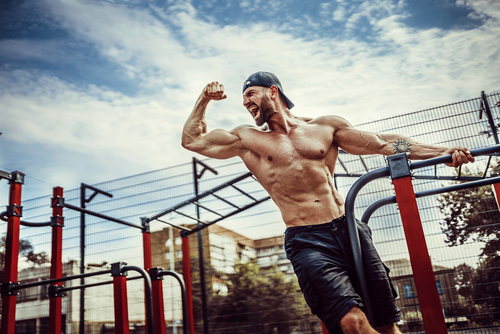
Warm-Ups for Calisthenics
Before you begin any exercise, make sure to start with a 5-10 minutes light warm-up of light cardio. I personally love using the stationary bike at the gym, but if you don’t have access to one, just go for a brisk walk or jog around your building/neighborhood.
Jumping Rope
The first thing you should do for your warm-up is to get yourself a skipping rope, I recommend getting one with “Ball Bearing” technology because it will make the exercise smoother and more comfortable.
The jumping rope helps to pre-activate muscles in your legs; it also helps to raise your heart rate, which gives you more energy when you go to do your workout.
I recommend getting a good rope for around $15-$20 on Amazon, but you can also buy them at most sports stores or even 5 Below.
Stretch Before and After
Always stretch before your workout to avoid injuries. I normally hold each stretch for 30 seconds, but you can go on Google and search if you want more specific stretches.
After your workout is also a great time to let those muscles rest and recover, don’t skip the stretching after as well.
Can Calisthenics Build Muscle?
Yes, of course, calisthenics can build muscle. Granted, you won’t become a pro bodybuilder by doing calisthenics, but you will have a good lean body if done right.
Obviously, when you can do 20-30 push-ups at a time and over a dozen pull-ups, you will add muscle, not bulky muscle, though. This is lean and athletic muscle.
Calisthenics vs Weightlifting
Alright, here’s the deal. Calisthenics and weightlifting aren’t enemies. You don’t need to pick one like it’s some kind of loyalty test.
They both work. They both build strength. But they do it in different ways.
Calisthenics is all about mastering your own bodyweight. Push-ups, pull-ups, dips, squats, simple stuff on paper, but absolutely brutal when done right. It builds coordination, core strength, flexibility, and lean muscle without needing much more than a pull-up bar and a patch of floor. It also forces you to get stronger relative to your body, which honestly might matter more in real life than how much you can deadlift in a hoodie and headphones.
Weightlifting, on the other hand, is more structured. You’ve got total control over your load, your progression, your split, your tempo, all of it. It’s excellent for building max strength and size. But you need a gym, or at least some gear, and not everyone has that.
Traveling? Stuck at home? Calisthenics is your guy. Trying to bulk like a linebacker? Weights are going to get you there faster. But most people don’t have to choose. You can squat and do pull-ups. You can deadlift and crank out dips. You’re allowed.
Honestly, the smartest approach is blending both. Use weights for progressive overload and calisthenics to build movement control and athleticism. They complement each other. You’ll move better, feel better, and yeah, look better too.
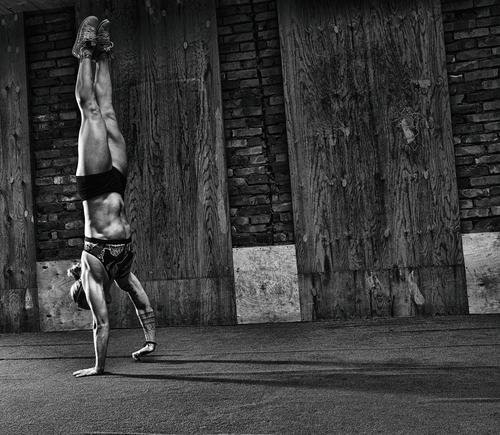
Muscles Worked with Calisthenics
People often assume that calisthenics work only the most basic of muscles, but in fact, they activate many small stabilizing muscles along with the major muscle groups. This means a great workout for all the most important muscle groups. The list of major muscle groups activated by calisthenics includes the biceps, triceps, pectorals, abdominals, latissimus dorsi (lats), gluteus maximus, quads, and deltoids. But you can include pretty much every muscle in your body in that list if you are training right.
Calisthenics are a gift to the body because they work everything without taking away from any of your other activities such as running, cycling, or playing a sport. These exercises help with injury prevention and flexibility, which is highly beneficial for almost every activity.
Calisthenics Workouts
Calisthenics workouts are incredibly beneficial for weight loss, strength training, and endurance. The #1 way to see great results with calisthenics is to use circuit training to do several different moves back-to-back one after another without rest. This allows you to increase your heart rate while working out multiple muscle groups at once and helps you to work up a good sweat.
Workout A
Push-ups 3 sets of 5-15 reps
Pull-ups 3 sets of max reps
Air Squats – 3 Sets of 10-20 Reps
Crunches (sit ups) 3 sets of 20-30
Workout B
Pull-ups or chin ups – 3 sets of max reps
Bodyweight Rows – 3 Sets of 10-15 reps
Lunges – 2 sets each side x 15-30 reps
Planks – 3 sets to failure
Jump Rope – 5 Minutes
Workout C
Circuit Training
3 Rounds of:
- 25 Jumping Jacks
- 15 Jump Squats
- 25 Calf Raises
- Max Chin-ups
- Max Close Hand Push-Ups
- 1 Minute Plank
- Rest 3 minutes
Intermediate Calisthenics Workout
3 Rounds of:
- Muscle-ups – As many as possible
- Handstand push-ups – 10 reps
- Jump Squats – 25 reps
- Hanging Leg Raises – 10-15 reps
- Sprint – 30 seconds
- Rest – 2 minutes
Conclusion
You don’t need a gym. You don’t need a barbell. You don’t even need pants. Calisthenics are raw, primal, and brutally effective. Whether you’re just getting started or ready to try a human flag, this style of training builds real strength, real muscle, and real grit. Now get moving.

Ryan is a former college wrestler and lifelong fitness fanatic with over 25 years in the industry. He’s run half marathons, tackled mud runs, placed in body transformation contests, and coached everything from wrestling to girls’ soccer.
Along the way, he’s tested hundreds of supplements and built a deep well of supplement knowledge. His work has appeared in Muscle & Strength, Testosterone Junkie, The Sport Review, and more. Today, he’s the editor-in-chief of this site, still training hard and helping others reach their goals. Connect with him on LinkedIn below.
